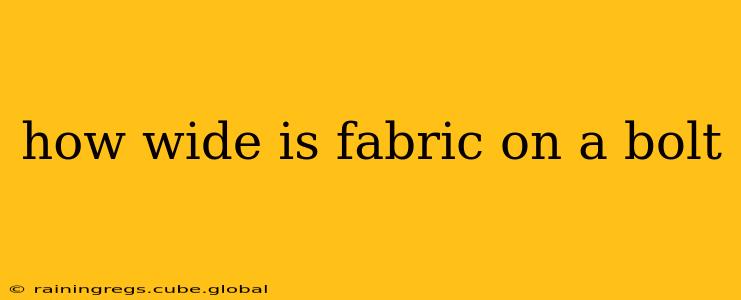How Wide is Fabric on a Bolt? A Comprehensive Guide to Fabric Widths
The width of fabric on a bolt isn't a one-size-fits-all answer. It varies significantly depending on the type of fabric, its weave, and even the manufacturer. Understanding fabric widths is crucial for accurate estimations in sewing projects, avoiding costly mistakes, and optimizing your fabric purchases. This guide will delve into the common widths, variations, and factors influencing fabric dimensions.
What are the common fabric bolt widths?
The most common fabric bolt widths are 43-45 inches (109-114 cm) and 54-60 inches (137-152 cm). However, you'll encounter fabrics outside this range. For example, some specialty fabrics, like quilting cotton, might be a consistent 42" or 44". Wider fabrics, such as those used for drapery or upholstery, can reach 120 inches or more. Always check the listing for specific dimensions when ordering online or purchasing from a retailer.
How does fabric type affect width?
The type of fabric heavily influences its width. Here are a few examples:
-
Cotton: Cotton fabrics, especially quilting cottons, often come in widths around 42-44 inches. However, broader cotton fabrics for apparel or home decor can be found in the 54-60 inch range.
-
Linen: Linen's width can vary, but it often falls within the 45-54 inch range.
-
Silk: Silk fabrics also exhibit a range of widths depending on the type and weave, often between 45 and 54 inches.
-
Woven Fabrics vs. Knit Fabrics: Woven fabrics generally have more consistent widths compared to knit fabrics, which can be more prone to variations depending on the knitting process.
-
Specialty Fabrics: Upholstery fabrics, drapery fabrics, and other specialty fabrics can have significantly wider widths, often exceeding 60 inches.
What are the typical width variations I might encounter?
Even within a stated width, you might find slight variations. A bolt labeled "54 inches" might actually measure slightly less or more in certain areas due to the manufacturing process. This isn't usually a significant issue unless you are working on a precise project, such as a quilt with tightly matched patterns. Always pre-wash your fabric to account for shrinkage, which can affect the width as well.
Why is knowing fabric width important for my projects?
Knowing the fabric width is crucial for several reasons:
-
Accurate Cutting and Sewing: It allows you to accurately calculate the amount of fabric needed for your project, preventing waste and ensuring you have enough material.
-
Pattern Matching: For patterns that require matching, knowing the width helps you plan how to cut the fabric to achieve the desired effect.
-
Cost Optimization: Accurate calculations based on fabric width help you avoid overbuying or underbuying, which can save you money.
-
Project Planning: Accurate estimations based on fabric width are crucial for proper project planning, including determining cutting layouts and sewing time.
What should I do if I'm unsure of the fabric width?
Always check the product description when buying fabric online. Reputable online retailers provide detailed information including dimensions. If purchasing from a local store, don't hesitate to ask a staff member to confirm the width of the fabric bolt before making a purchase.
By understanding the common widths and variations in fabric, you'll be better equipped to plan and execute your sewing projects efficiently and accurately. Remember to always account for potential shrinkage and minor variations in width when cutting and sewing your projects.
